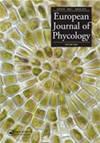Genomic analysis of the lectotype specimens of European Ulva rigida and Ulva lacinulata (Ulvaceae, Chlorophyta) reveals the ongoing misapplication of names
IF 1.7
4区 生物学
Q2 MARINE & FRESHWATER BIOLOGY
引用次数: 24
Abstract
ABSTRACT Species of Ulva Linnaeus are nearly impossible to identify using morpho-anatomy due to their simple thallus structure and phenotypic plasticity. The current solution to this problem is to sequence DNA from field-collected specimens and match these sequences to those available in public DNA databases. However, because type specimens of many species have not been sequenced, the accuracy of these identifications is highly doubtful. Ulva rigida C.Agardh is reported to be one of the most widespread and ecologically important Ulva species, but these records are based on either morpho-anatomy or, more recently, on DNA sequences. High-throughput sequencing (HTS) was performed on the lectotype specimen of U. rigida from Cádiz, Spain to determine the correct application of the name. The analysis yielded its complete plastid genome. rbcL, tufA and ITS sequences from the lectotype specimen differed at the species level from all U. rigida sequences deposited in public databases. Instead, the lectotype sequences of U. rigida were identical or very similar to sequences identified as U. rotundata Bliding (referred to by some as U. pseudorotundata Cormaci, G.Furnari & Alongi) from Ireland and Portugal, but not to the holotype of U. rotundata from Italy, which was identical to U. lactuca L. HTS of the lectotype of U. lacinulata (Kützing) Wittrock from Lesina, Croatia, a species morphologically similar to U. rigida with macroscopic marginal teeth, also yielded a complete plastid genome, with sequences identical or highly similar to GenBank U. armoricana Dion, Reviers & Coat, U. ‘laetevirens’, U. ‘rigida’ and U. scandinavica Bliding. Since U. lacinulata is the oldest validly published name, it is the correct one to apply to the globally distributed species that was previously but incorrectly known as U. rigida. Based on this genetic evidence, U. rigida is restricted to European waters and confirmed by DNA sequences from Ireland, Portugal and Spain. This analysis shows that many barcode species identifications and taxonomic conclusions in the genus Ulva are incorrect. Highlights Ulva rigida was misapplied and is restricted to Atlantic Europe. Ulva lacinulata is the dentate species of Ulva distributed worldwide. Ulva rotundata is a heterotypic synonym of U. lactuca.对欧洲硬叶榆(Ulva rigida)和紫叶榆(Ulva lacinulata, ulvacae,吊藻科)选种标本的基因组分析揭示了名称的误用
由于林奈榆(Ulva Linnaeus)的菌体结构简单,表型可塑性强,几乎不可能通过形态解剖学来鉴定其种类。目前解决这个问题的方法是从野外采集的标本中对DNA进行测序,并将这些序列与公共DNA数据库中的序列相匹配。然而,由于许多物种的模式标本尚未测序,这些鉴定的准确性非常值得怀疑。据报道,Ulva rigida C.Agardh是分布最广、生态最重要的Ulva物种之一,但这些记录要么是基于形态解剖学,要么是最近的DNA序列。采用高通量测序(HTS)对来自Cádiz,西班牙的U. rigida标本进行测序,以确定名称的正确应用。分析得出了它完整的质体基因组。该标本的rbcL、tufA和ITS序列在种水平上与公共数据库中所有僵菌序列存在差异。相反,U. rigida的选型序列与来自爱尔兰和葡萄牙的U. rotundata blding(被一些人称为U. pseudorotundata Cormaci, G.Furnari & Alongi)的序列相同或非常相似,但与来自意大利的U. rotundata的全型序列不相同,后者与来自克罗地亚Lesina的U. lacinulata (k tzing) Wittrock的选型序列相同,后者与U. rigida形态相似,具有宏观边缘齿。也获得了一个完整的质体基因组,序列与GenBank的U. armoricana Dion、Reviers & Coat、U. laetevirens、U. rigida和U. scandinavia Bliding相同或高度相似。由于U. lacinulata是最古老的有效发表的名称,它是适用于全球分布的物种的正确名称,以前被错误地称为U. rigida。基于这一基因证据,僵鱼仅限于欧洲水域,并由爱尔兰、葡萄牙和西班牙的DNA序列证实。这一分析表明,该属的许多条形码物种鉴定和分类结论是不正确的。Ulva rigida被误用,仅限于大西洋欧洲。带齿Ulva lacinulata是分布在世界各地的Ulva有齿种。圆叶Ulva round undata是一种异型同义植物。
本文章由计算机程序翻译,如有差异,请以英文原文为准。
求助全文
约1分钟内获得全文
求助全文
来源期刊

European Journal of Phycology
生物-海洋与淡水生物学
CiteScore
4.80
自引率
4.20%
发文量
37
审稿时长
>12 weeks
期刊介绍:
The European Journal of Phycology is an important focus for the activities of algal researchers all over the world. The Editors-in-Chief are assisted by an international team of Associate Editors who are experts in the following fields: macroalgal ecology, microalgal ecology, physiology and biochemistry, cell biology, molecular biology, macroalgal and microalgal systematics, applied phycology and biotechnology. The European Journal of Phycology publishes papers on all aspects of algae, including cyanobacteria. Articles may be in the form of primary research papers and reviews of topical subjects.
The journal publishes high quality research and is well cited, with a consistently good Impact Factor.
 求助内容:
求助内容: 应助结果提醒方式:
应助结果提醒方式:


